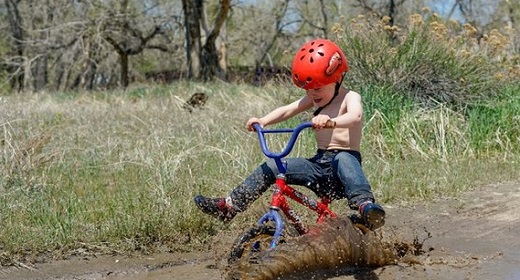by Amanda Baker: Giant leaf piles, the Mythbusters and remembering what it was like to be a curious kid…

There is a toddler in my son’s daycare who likes to dig through bags. Or boxes. Or anything new, really. One of the other parents had playfully referred to her as nosey, and it was clear that no harm was meant. But then their teacher chose a different phrase. “Curious,” the teacher said. “She’s curious.” More than once since, I have felt the urge to self-correct with my own word choices. When a child is drawn to the giant pot of dirt, fresh splatter of bird poop, or pile of rotting leaves, it isn’t some cosmic attraction to the thing capable of making the biggest mess. At least some part of it is curiosity. I am constantly reminded how much young children are pattern-recognition machines, with my son getting home and immediately walking over to pick up the single new can on a low shelf. As someone who cares about fostering the natural curiosity young people have to carry them across the middle-school threshold when science transforms from interesting to hard, I am having to remind myself to look more closely at young curiosity and realize how different it might look than the same feeling in grown ups.
Images of grown-up curiosity seem to have a lot of chin scratching and pensive gazes. Stock photo searches have a lot of serious faces and tilted heads, though the kids’ versions do have more smiling. As adults, it is easy to picture that youthful curiosity looks a lot like grown-up curiosity, but with a trendier vocabulary and more exclamation points. But take a moment to picture a kid with a jack-in-the-box, giant pool noodle, or bubble wrap. There will be some scrunched eyes and head tilting, but there will be a lot of giggling. Somehow that sense of anticipation – either for the completely unknown or the newly expected – is interwoven with barely contained glee.
As an academic, I only experienced that kind unconstrained enthusiasm among peers once. After an seven-year journey to Saturn, the Cassini-Huygens spacecraft had finally started to send back pictures. Even though there had not been much time for scientific interpretation, the geology conference hosted a session that was little more than a glorified slideshow from a new world. The room was packed. As new images came up on screen, there would be bursts of excitement. There were bubbles of laughter and collective gasps. It was the shameless joy of discovery again. There are other moments when emotions are able to crack through the professionalism and the objectiveness – like the videos of ground control the moment a lander makes it safely to the surface. The joy is there, but it seems to take more for grown ups to tap into it.
But trying to capture the investigative style of the young people in my life has demanded the use of many compound phrases: targeted recklessness, shameless persistence, or gleeful abandon. Regardless of how many exclamation points we use or how many times we declare something to be cool, a lack of recklessness (or a presence of shame, or a lack of abandon) can form a barrier between the grown-up world and youthful curiosity. The people who can bridge that divide tend to stand out.
Trying to imagine what true, gleeful abandon might look like in a grown up, my mind didn’t go to great innovators or grand adventurers. It went to the Mythbusters. For every critique out there about representations of scientific rigor – which are fair and worth acknowledging – the Mythbusters seem to have a direct line to the anticipatory joy typically associated with childhood discovery. Adam Savage standing in front of an arena of banana peels waiting to run in is practically vibrating with glee. Even Jaime Hyneman – with all his buttoned-up, well-pressed persona – can be brought to giggles with a sufficiently ominous new piece of hardware. And after being warned to never, ever try any of the things the hosts are about to do at home, viewers get to watch the Mythbusters do all of the things they wish they could do if their own personal risk/reward assessments were scaled a bit differently.
Think about the relative risks and rewards perceived by kids and adults for a bowl of flour or pile of leaves. A child who does not need to do laundry, pay for groceries, or know what a dislocated finger feels like is naturally going to see the potential rewards as far outweighing any perceived risk. In many cases their young minds will run through the many possible scenarios (most of them glorious) and dive in, giggling. But gleeful abandon and respect for risk don’t have to cancel each other out. Again, I am drawn to the Mythbusters as examples. The Mythbusters are not just engaging in risky activity for the sake of fame or some kind of shadenfreude-driven entertainment (those shows never held much appeal for me). They were asking questions, consulting experts, taking safety precautions, and assessing risk as they investigated questions all across the spectrum from respectable to ridiculous.
The Mythbusters put a blind man behind the wheel of a car, careened speeding cars into the front of snowplows, and intentionally overrode the safeties on hot water tanks for a reason. They also assessed the risk and (thankfully) decided against putting Tory upright on the back of a speeding pickup. Sometimes they were right – deciding against dropping Adam off of a roof and through a series of awnings likely prevented disaster. Sometimes they were wrong – I can still picture the bloody shins and clenched teeth when they decided to test the effectiveness of the brace position with people instead of dummies. And those few instances when the giggles and playful banter disappeared, like when Adam was preparing to test methods for escaping an underwater car, the viewer knew how high the stakes were. But they were honest about the risk without losing the joy, and that can fall right into a kid’s sweet spot.
Obviously I am, and probably always will be, a fan. My husband and I dressed up as Adam and Jamie for Halloween and went to see their farewell tour. I will bemoan the fact that I will be too old and my son will be too young (and on the wrong side of the country) to take part in the new Mythbusters Jr. series. And while I don’t believe that I need to blow things up in the backyard for the sake of inquiry, I can try to remember that giving youthful curiosity a chance to thrive should fall in the potential reward column of any risk assessment. Laundry can be washed. Leaves can be raked again. And when the opportunity arises to embrace the giggles of a new, youthful experiment, I will do my best to try to embrace the glee myself.
















































